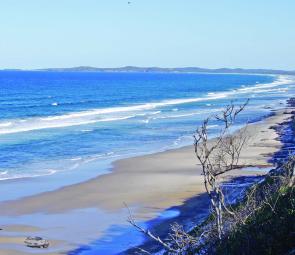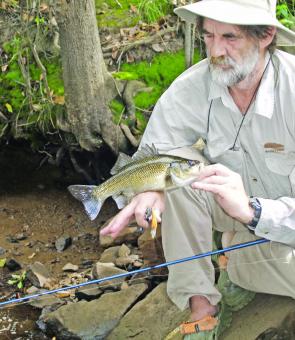Happy holiday time! If you haven’t got used to the crowds along the coast by the time you read this, you’d better start fishing before first light or around dark.
As well as avoiding sunburn and the often frantically busy periods at the beach, boat ramps and in the estuaries, you’ll catch more fish if you’re waking up the chooks as you head out.
Although the populations of local coastal towns and villages double or even treble at this time of year, you can still almost feel you have the place to yourself while everyone is still slumbering and the fish are out chasing up breakfast.
By the time the crazy boat traffic starts on the estuaries around 8am or 9am, you should have finished cleaning your catch or be going through the brag photos on your camera and settling in for a snooze somewhere shady and cool.
You’ll definitely need to be at the ramp pre-dawn if you’re heading offshore and plan to cross the bar as soon as you can see the incoming waves. The best bite in close for snapper and trag occurs at first light and there’s the promise of a passing mackerel if the water is warm and clear.
As the day brightens, head out to deeper reefs for reds and kingies or hunt down some pelagics around the FADs or current lines. Five or six hours of these pursuits and the north-easterly should be starting to kick in and it’s time to head home before the bar roughens up too much.
You can start even earlier if you’re hitting the estuary, as long as you know where you’re going in the dark. Mangrove jacks and big-eye and juvenile giant trevally feed best in the pre-dawn and flathead hunt in very shallow water, especially on the top half of a falling tide. Any jewie fisho will tell you that that’s a witching hour for the big silver fish, too.
Later in the day it’s best to concentrate on deeper water with a bit of colour for flathead, bream and whiting.
The running flats in about 4m around Burns Point to Pimlico will be popular for whiting, especially on the bigger tides around January 8 to 13 and again from January 20 to Australia Day.
You’ll need a fair sinker to keep the bait down in the strong run but if you have secured a supply of bloodworms you’ll end up with some large, delicious fillets.
The shallower water adjoining these running flats should also hold some joy for those throwing poppers for the whiting.
And if the crowds get too much you can always plan an expedition inland, where bass should be active and hungry right up into the headwater streams beyond Lismore and Casino.
Or there’s the beach. There have been some quite acceptable catches off the beaches, particularly whiting, bream and school jew, although you can probably add tailor to that list as well.
Those casting plastics in the surf have been having a ball and even most of the veteran bait fishos have turned to the dark side once they’ve seen how much the school jew and bream love 3” to 5” soft stickbaits on light jigs.
Soft plastic worms haven’t quite made the same inroads on the fresh beach worms for whiting but they’ll still bite on them at times.
On a big high tide not long ago I came upon a couple of fishos who’d parked their 4WD way up in the dunes among the spinifex and coastal wattle. They were struggling to keep a bait out as the tide and wind swept down the beach. There’d been good fish in some of the holes at low tide but these formations were now 70m seaward as the shore break swept up to the dunes.
It was a case of bad timing for this pair but there was plenty of bad judgment as well. They’d driven about 100m along the beach from the signposted access point and had perched their vehicle on the frontal dune so it didn’t get wet.
The dumbest part was that there was a short pedestrian access track only a few metres away that led to a shady parking spot on a sealed road. These people appeared to have perfectly functioning legs yet the umbilical tie to the vehicle was just too much.
You don’t need a permit to drive on 18km or more of local beach, from Airforce Beach at Evans Head north to the South Ballina access point a kilometre or so down from South Wall. You do, however, need some common sense.
The strip from Evans to Broadwater is part of the Broadwater National Park and there are plenty of folk of a dark green hue who’d love to have vehicles banned from this strip, and the rest of the beach to South Ballina. Don’t give them any ammunition to force a closure.
There are signs at vehicle access points giving a list of dos and don’ts, detailing speed limits, safe distances from other beach users (including pied oystercatcher birds), and where not to drive or park. Read and follow these rules or one day soon none of us will be able to drive the beach to fish.
Especially on the high spring tides around new moon and full moon, there often isn’t much sand, with the waves lapping the spinifex on the frontal dune in places. The remaining sand is mostly soft and deep – hardly enjoyable driving – and the surf meets the fragile coffee rock at Broadwater Beach. So why would anyone be dumb enough to drive over the grass or carve huge ruts over the soft rock, especially when a few hours before or later there’s dry, firm sand on a lower tide?
If you’re keen to test your you-beaut 4WD in tough terrain, go to a 4WD park or up to Fraser Island and play with the big kids instead of jeopardising fishing access for the rest of us.
Reads: 1656
There are kilometres of beach to drive between Ballina and Evans Head but don’t waste your time attempting it at high tide. Driving or parking on Fragile coffee rock and dune vegetation should be avoided at all costs.

When the coastal crowds get too much you can always head inland to the sweetwater streams for willing bass of all sizes.




